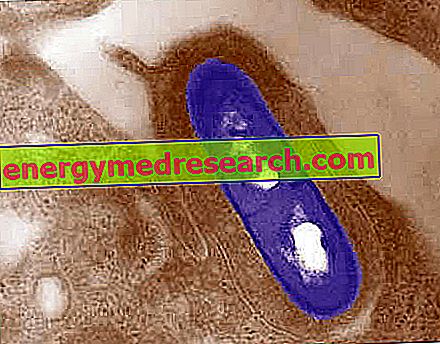Generality
By the term Marker ( indicator ), in biochemistry and biology, we mean a molecule that "indicates" a specific tissue damage .
The indicators of this damage can be multiple and differ depending on the type of tissue being damaged.

Markers, or "indicators" of tissue damage, can be of various nature, depending on the place where the lesion occurs; therefore we can find markers of proteic, enzymatic, lipidic etc. nature.
For this reason, tissue damage markers can be distinguished into:
- Little specific markers
- Non-specific markers
- Specific markers
Let's analyze them individually.
Little specific markers
The little specific Markers are indicators of tissue damage circumscribed to a group of organs or tissues, which however do not allow to identify and isolate the "case". For example, myoglobin is a marker of generic muscle damage, but does not allow it to be specifically limited to skeletal or cardiac muscle. The same applies to creatinkinase .
Non-specific markers
Nonspecific Markers are indicators of tissue damage that cannot be circumscribed to a specific case. An example is given by lactate dehydrogenase .
Specific markers
Finally, specific markers are indicators of tissue damage that unequivocally refer to a single tissue. For example, cardiac troponins or the CK-MB isoform of creatinkinase.
What are
Tissue damage markers are molecules released into the bloodstream when a particular organ or tissue in the body suffers severe stress, or suffers as a result of a significant pathological event (such as injury, ischemia, inflammation or infection).
The evaluation of these markers therefore serves to determine or monitor the presence of pathologies that cause tissue or cellular destruction.
Because they measure themselves
The measurement of tissue damage markers is used as a support in the diagnostic classification of a specific pathology and to determine the prognosis and / or the response to a possible treatment. Furthermore, these indicators can be used to assess the risk that the patient has of developing a specific disease.
The examination of markers is usually prescribed in association with other diagnostic tests, when the doctor suspects that the patient has an acute or chronic pathology responsible for tissue or cellular damage and destruction.
The dosage of tissue damage indicators can also be indicated when the patient has an accumulation of fluid in a specific area of the body (such as the brain, heart or lungs), or is affected by a tumor.
Associated examinations
Often, other investigations are prescribed together with markers to assess the patient's general health, as well as the state of the kidneys, liver, electrolytes and the acid / base balance, blood glucose and plasma proteins.
These exams may include:
- Blood count with formula;
- Blood Gas;
- Renal panel;
- Hepatic profile;
- Electrolytes;
- Electrocardiogram (ECG);
- MRI scan.
Tissue damage marker: some examples
- Troponin : is the most specific heart damage marker.
Troponins are proteins found in skeletal and cardiac muscle. They regulate muscle contraction, controlling the calcium-mediated interaction of actin and myosin. The specific isoforms of the heart (TnI and TnT) are considered one of the most important diagnostic references to evaluate the health status of the heart muscle; in clinical practice, these markers are used to understand if the patient has had a heart attack or other inflammatory or ischemic problems.
- Creatine kinase (CK) : it is an enzyme present mainly in skeletal muscle tissue and in cardiac fibers. The measurement of the amount of creatine kinase (CK) present in the blood allows the detection and monitoring of inflammation (myositis) or serious muscle damage, including cardiac damage. In the presence of a suffering of the muscle, in fact, increased amounts of CK are released into the blood within a few hours. If further damage occurs, CK concentrations can remain high. This makes the CK test useful for monitoring progressive muscle or cardiac damage.
- Creatine kinase-MB (CK-MB): is a particular form of the enzyme creatine kinase that is found mainly in the heart muscle. CK-MB levels increase when cardiac damage occurs. This marker can be used in follow-up, after finding a CK increase, and / or when the troponin test is not available.
- Myoglobin : together with troponin, this protein represents one of the most used markers to confirm or exclude any damage to the heart. Myoglobin levels begin to increase within 2-3 hours of heart attack or other muscle damage, reaching high levels in the next 8-12 hours; generally, the values return to normal the day after the pathological event. As a result, the exam is used to help rule out a heart attack in the emergency room.
- Lactate dehydrogenase: it is an enzyme found in most of the body's cells. Its main task is to metabolize glucose to make it energy usable. Lactate dehydrogenase is found in numerous tissues, but is concentrated mainly in the skeletal muscles, liver, heart, kidneys, pancreas and lungs. When the cells are damaged or destroyed, the LDH enzyme is released into the liquid fraction of the blood (serum or plasma), as well as increasing its concentration in other biological liquids (eg liquor) in the presence of certain diseases. Therefore, LDH is a general indicator of tissue and cellular damage.
Normal values
Troponin
In the body of a healthy individual, the reference values of cardiac troponin are almost zero:
- Troponin T: 0.2 mg / l;
- Troponin I: 0.1 mg / l.
Creatine kinase
The normal values of creatine kinases are not easily identifiable, as they can be influenced by various factors, including muscle mass and quantity / quality of physical training. However, these are usually in the range 60 - 190 U / L.
CK-MB
In general, normal CK-MB values between 0 and 25 IU / L are considered.
Myoglobin
Normal levels of myoglobin in the blood: 0 - 85 ng / mL.
Lactate dehydrogenase
The normal LDH values are between 80 and 300 mU / ml.
Note
The reference interval of the tissue damage markers can change according to age, sex and instrumentation used in the analysis laboratory. For this reason, it is preferable to consult the ranges listed directly on the report. It should also be remembered that the results of the analyzes must be assessed as a whole by the general practitioner who knows the patient's medical history.
High Tissue Markers - Causes
Troponin
Cardiac troponins are heart-specific isoforms and are normally present in very small amounts.
When damage to cardiac muscle cells occurs, concentrations of TnI and TnT (cardio-specific troponins) increase within 3-4 hours of the event and can remain high for 10-14 days.
Possible causes of increased cardiac troponins include heart attack, cardiac ischemia, angina pectoris and myocarditis (cardiac inflammation).
Troponin concentrations may also increase following other diseases, such as serious infections and kidney diseases.
Creatine kinase
The presence of a high value of creatine kinase can be due to heterogeneous causes, including fatigue (eg physical exertion, intense sports training, etc.), muscle diseases (such as dystrophy) or myocardial infarction.
The causes that determine the increase in CK also include trauma, thyroid dysfunction, alcohol abuse and infectious diseases.
CK-MB
The values of CK-MB rise in the presence of damage to the heart muscle - such as acute myocardial infarction - of a trauma or heart surgery.
Myoglobin
When myoglobin increases, it means that there has been recent damage to the heart or other muscle tissue. The increase in this marker indicates an ongoing cardiac distress and may be related to a myocardial infarction.
High levels of myoglobin must be compared with the results of other tests, such as creatine kinase (CK-MB) or troponin; this makes it possible to establish whether the damage is actually on the heart or involves a skeletal muscle.
An increase in myoglobin values can also be found in cases of trauma, surgery or myopathies, such as muscular dystrophy.
Lactate dehydrogenase
The increase in LDH can occur in all pathological conditions characterized by the development of irreversible cellular damage (necrosis), with loss of the cytoplasmic content.
The possible causes include heart attack, haemolytic anemia, infectious diseases, nephropathy, stroke, muscle injuries, trauma, liver disease and various cancers.
Low Tissue Markers - Causes
Troponin
The finding of a low level of cardiac troponins indicates the unlikely infarction and / or heart damage.
Creatine kinase
The most common causes of low CK values include Addison's disease, poor muscle mass, pregnancy and liver disorders.
CK-MB
Normally, CK-MB is not detectable in the blood or is very low. In general, therefore, there is no anomaly concerning too low levels of the isoenzyme.
Myoglobin
Low levels of myoglobin are not usually associated with medical problems and / or pathological consequences.
Lactate dehydrogenase
Low or normal values of lactate dehydrogenase do not generally indicate a problem. In some cases, reduced concentrations can be observed when the person has ingested large amounts of ascorbic acid (vitamin C).
How to measure them
- Tissue damage markers are measured on a blood sample taken from a vein in the arm.
- Sometimes, to determine the value of these indicators, a specific procedure can be performed to collect a sample of liquid in a particular area of the body (for example, around the heart or lungs or in the abdominal cavity).
Preparation
The preparation may vary according to the tissue damage marker to be evaluated. In general, blood should be taken preferably after an 8 to 10-hour fast.
Interpretation of Results
The concentration of these markers present in the blood or in other biological liquids can help to determine the cause of tissue damage and to determine its extent. In particular, their evaluation can be useful for the doctor as an alarm bell that indicates the presence of inflammations, lesions, infections or specific pathological conditions.
In any case, it should be remembered that the results of each examination should not be interpreted alone, but always in the light of the results of other analyzes, which may be indicated by the doctor, from time to time.



